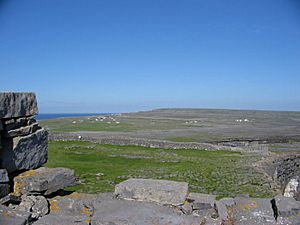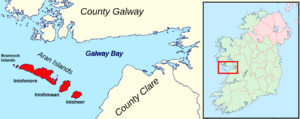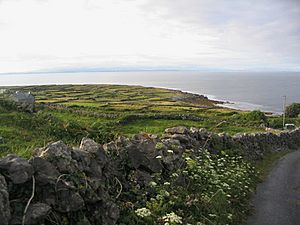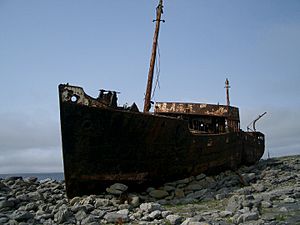Aran Islands facts for kids
The Aran Islands (called Oileáin Árann in Irish) are a group of three islands. They are located at the entrance of Galway Bay, on the west coast of Ireland. The islands cover about 46 square kilometers (18 square miles). They are part of County Galway.
From west to east, the islands are:
- Inishmore (Árainn Mhór or Inis Mór) – This is the largest island.
- Inishmaan (Inis Meáin) – This is the second largest island.
- Inisheer (Inis Oírr) – This is the smallest island.
About 1,200 people live on the islands. Most of them speak Irish, which is also used for local place names. All islanders also speak English well. The islands are part of the Gaeltacht, which means Irish is the main language spoken there.
Contents
Getting to the Aran Islands
You can reach the Aran Islands by ferry or by plane.
- Ferries go to all three islands from Rossaveal in County Galway all year round.
- You can also take a ferry from Doolin in County Clare during certain seasons (April to October).
- Flights are available from Inverin to Inishmore.
There are different water passages around the islands:
- North Sound (An Súnda ó Thuaidh) is between Inishmore and the mainland.
- Gregory's Sound (Súnda Ghríoghóra) is between Inishmore and Inishmaan.
- Foul Sound (An Súnda Salach) is between Inishmaan and Inisheer.
- South Sound (An Súnda ó Dheas) is between Inisheer and County Clare.
History of the Islands
People probably first came to the Aran Islands looking for a safe place. The islands are made of limestone and don't have natural topsoil. Early settlers made their own soil by mixing seaweed and sand from the shore. They built drystone walls to protect this new soil.
There are seven old stone forts on the islands. One famous fort is Dún Aonghasa on Inishmore. It was built around 1100 BC.
In 490 AD, Enda of Aran started the Killeany monastery on Inishmore. It became a place for learning. Another old church on Inishmore is Tempull Breccain, from the 5th century. On Inisheer, a ringfort called Dún Formna later became the site of O'Brien's Castle. This castle was built around the 14th century.
In the past, people lived in small, single-story cottages with thatched roofs. Men often wore clothes made of homespun tweed. Women wore long skirts and knitted sweaters. Aran knitters were very skilled.
In the 1820s, people collected kelp (seaweed) to earn money for their land rent. They also used wood washed ashore for building and fuel.
The famous writer John Millington Synge spent summers on the Aran Islands starting in 1898. His play Riders to the Sea is set on Inishmaan. He also wrote a book called The Aran Islands in 1907, based on his time there. His experiences on the islands greatly influenced his plays.
Island Landscape and Climate

The islands are mostly made of karst limestone. This is similar to the Burren area in County Clare. You can see this in the many stone walls built around the fields.
The limestone formed about 350 million years ago from sediments in a tropical sea. You can find fossils of corals and sea creatures in the rocks. The last ice age shaped the islands, creating a special landscape called Glacio-Karst. This means the limestone has cracks and flat slabs formed by water.
Huge boulders, some as high as 50 meters (164 feet) above the sea, can be found on the west-facing cliffs. Scientists have shown these were moved there by powerful storms, not tsunamis.
The Aran Islands have a mild climate. Temperatures usually range from 6°C (43°F) in January to 15°C (59°F) in July. Grass grows for a long time here, making it a great place for many different plants to grow. Late May is a good time to see flowers like gentians and avens.
Plants and Animals
The islands are home to a mix of arctic, Mediterranean, and alpine plants. This is very unusual! Like the Burren, the Aran Islands are known for their amazing collection of plants and animals.
The cracks in the limestone (called grikes) provide moist shelter for many plants, including small shrubs. Where the rock surface is broken into gravel, you can find hardy arctic or alpine plants. In areas with thin soil, you'll see patches of grass with flowers like gentians and orchids.
You can also find interesting insects here, such as different types of butterflies and moths.
Traditional Life and the Irish Language

On the cliff tops, you can see ancient forts like Dún Aonghasa on Inishmore and Dún Chonchúir on Inishmaan. These are some of the oldest historical sites in Ireland. The islands also have a huge network of old stone walls, stretching for about 1,600 kilometers (1,000 miles)! These walls enclose small fields for farm animals.
You can also find early clocháns, which are dry-stone beehive huts from early Christian times. Enda of Aran founded the first Irish monastery near Killeany. Over time, many monasteries were built on Inishmore alone. Many Irish saints had connections to Aran, and it was called the "Sun of the West." There are 38 national monuments on the Aran Islands.
Many people moved to the islands in the mid-17th century. They learned to live off the land and sea. They created fertile soil by mixing sand and seaweed on top of rocks. This allowed them to grow potatoes and vegetables. They also used seaweed to grow grass for cattle and sheep. These animals provided leather, wool, and yarn for clothes like hide shoes, handwoven trousers, and knitted sweaters.
The islanders also built unique boats for fishing, called currachs. They built their thatched cottages from local materials or traded with the mainland.
The Aran Islands are an official Gaeltacht area. This means Irish is the main language used for all official services, including education. In the past, many older islanders spoke only Irish because the islands were quite isolated. Today, young islanders can finish their schooling on the islands. Many then leave for college on the mainland. Some people believe English-language television has led to fewer young people speaking Irish.
Getting Around the Islands
Each island has its own road network. The speed limit is 50 km/h (30 mph). Many visitors like to rent bikes, as it's a great way to explore the islands.
Things to See and Do
Many visitors come to the Aran Islands, especially in the summer. There are several interesting forts and attractions:
- Dún Aonghasa (Dún Aonghasa) is an old fort on a 100-meter (328-foot) cliff overlooking the Atlantic Ocean on Inishmore. It has several circular stone walls.
- Black Fort (Dún Dúchathair) is another ancient fort.
- O'Brien's Castle on Inisheer was built in the 14th century.
- Teampall Bheanáin is thought to be the smallest church in the world. It's unusual because it faces north-south instead of east-west.
- Teampall an Cheathrair Álainn has a holy well that inspired John Millington Synge's play The Well of the Saints.
Arts and Inspiration
The Aran Islands have inspired many artists and writers.
- Liam O'Flaherty, a famous Irish writer, was born on Inishmore in 1896.
- Máirtín Ó Díreáin, an important Irish language poet, was also from Inishmore.
- Since 2000, the Áras Éanna Arts Centre on Inisheer has welcomed artists from all over the world to live and create art.
- Clíodhna Lyons, an Irish cartoonist and animator, was born on the islands.
Many artists have visited the islands over the years.
- Harry Clarke, a famous stained-glass artist, spent summers on Inisheer in the early 1900s.
- Lady Gregory came to Aran in the late 19th century to learn Irish.
- Artist Seán Keating painted on the islands every year.
- Elizabeth Rivers moved to Aran and wrote two books about her art there.
Some visitors came to collect stories and folklore, seeing the islands as a "time capsule" of old Irish culture. The 1934 documentary Man of Aran shows the islanders' courage.
John Millington Synge's book The Aran Islands shares his personal experiences and tries to preserve information about the island's culture. The writer William Butler Yeats even told Synge: "Go to the Aran Islands, and find a life that has never been expressed in literature."
In the mid-20th century, some people came to the islands simply because they found the unique way of life interesting. They were drawn to the islanders' reliance on local stories, their isolation, and their simple farming and fishing life. These visitors often tried to live "as an islander." This way of life on Aran changed in the late 1970s due to more tourists and new technology.
Today, many visitors come for spiritual reasons, often interested in Celtic Christianity or New Age beliefs. Others come for general tourism, to see the ruins, hear Irish spoken, enjoy Irish music, and experience the unique geology of the cliffs. Books like Tim Robinson's Stones of Aran describe these visits.
Island Crafts
Aran Island Sweater
The islands are famous for the Aran sweater. This sweater became popular worldwide in the 20th century. Many sweaters sold on the islands today are made elsewhere in Ireland.
Aran Currach
The Aran currach is a special lightweight boat. It is made from canvas stretched over a thin wooden frame and then covered in tar. These boats are designed to handle the very rough seas of the open Atlantic Ocean. It is said that Aran fishermen did not learn to swim because if a currach sank in such rough seas, they would not survive anyway.
Even though they are strong, currachs can be easily punctured. In calmer weather, currachs used to go out fishing all night under the Cliffs of Moher. Today, they are mostly used closer to shore for lobster pots. Newer currachs are built for racing in local boat races called regattas or cruinnithe during the summer.
Fishermen wear soft calf-skin moccasins called pampooties. These are made from goatskin, calfskin, or cowhide, as regular shoes don't work well in the currachs.
Sports on the Islands
The limestone sea cliffs attract rock-climbers.
Popular GAA sports on the islands include Gaelic football, hurling, and Irish handball.
The annual Red Bull cliff-diving world championships are held on Inishmore every year.
Images for kids
See also
 In Spanish: Islas Aran para niños
In Spanish: Islas Aran para niños








